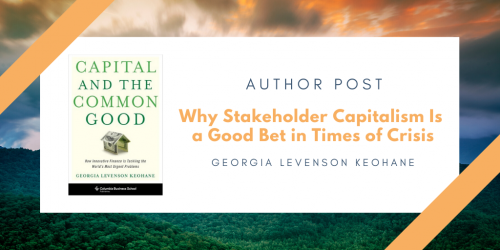How Damage to the Environment Leads to the Emergence of Previously Unknown Diseases
By Geoffrey Heal

“Geoffrey Heal’s scholarly work on environmental economics, the role of the state in economic life, and other contributions to economic analysis have been of great importance and wide reputation. He has now prepared a widely accessible yet careful and responsible study of the extent to which corporations can profit by adherence to socially valuable norms. The exposition makes no assumption of specialized knowledge yet fully reflects and imparts the soundest economic analysis.”
~Ken Arrow, Stanford University
Our observation of Earth Day continues today with this guest post by Geoffrey Heal, Donald C. Waite III Professor of Social Enterprise at the Columbia Business School and author of Endangered Economies: How the Neglect of Nature Threatens Our Prosperity.
For more from Heal, make sure to enter this week’s drawing for a chance to win a copy When Principles Pay: Corporate Social Responsibility and the Bottom Line.
• • • • • •
Endangered Economies: How the Neglect of Nature Threatens Our Prosperity gives a clear picture of why our economic activity brings us into conflict with nature, why this is so destructive for us, and how to solve the problem. Surprisingly, it’s conceptually straightforward. In this post, I’m going to zoom in on one point from the book that has suddenly become topical—the connection between our damage to the environment and the emergence of COVID-19 and other previously unknown diseases.
“It is our failure to conserve biodiversity that has put us at risk from zoonotic diseases such as COVID-19, SARS, and HIV.”
COVID-19 is zoonotic—it has jumped from wild animals to humans, who have no established immunity to the virus. SARS, the coronavirus that circulated in China in 2003, is also zoonotic, as are Ebola, an extremely dangerous hemorrhagic disease now threatening populations in west Africa, and HIV, which spread from Africa around the world. These diseases, which have probably been endemic in the wild animal populations for centuries or more, spread to humans as a result of increasingly close contact between humans and their wild carriers, largely through habitat loss, hunting, and consumption, which brings highly stressed or dead animals, exuding fluids, into close contact with each other and with their human consumers. A recent paper in Nature reviews the impact of biodiversity loss on the emergence and transmission of infectious diseases, and comments that “in recent years, a consistent picture has emerged—biodiversity loss tends to increase pathogen transmission and disease incidence,” suggesting that the growth we are seeing in new diseases is connected to the loss of biodiversity.1 It is our failure to conserve biodiversity that has put us at risk from zoonotic diseases such as COVID-19, SARS, and HIV. It is too early to know how many people will die from COVID-19, but it could clearly be in the millions. The dramatic spread of COVID-19, unprecedented in the last century, makes it only too possible to believe that something worse could happen in our lifetimes—for example, a virus that spreads just as easilybut has an even higher fatality rate, perhaps 20% rather than 2%. Stable biodiverse ecosystems are our principal barrier against such an outbreak.
“This reaction is fundamental to many modern biotechnology processes and it is fair to say that much of the modern biotech industry would not exists without it —we would certainly not be testing for COVID-19 without it.”
COVID-19 has another close connection with biodiversity conservation, because the test for the underlying virus relies on the polymerase chain reaction.2 This is a key element of modern biotechnology and is used to amplify DNA and RNA specimens. This reaction is fundamental to many modern biotechnology processes and it is fair to say that much of the modern biotech industry would not exists without it —we would certainly not be testing for COVID-19 without it. This reaction requires an enzyme that is resistant to high temperatures, and no such enzyme was known until the bacterium Thermus aquaticus was discovered in the Lower Geyser Basin of Yellowstone National Park. This relatively rare naturally occurring microorganism plays a key role in an evolving modern technology.
The bottom line: the biggest public health crisis of the last hundred years grew out of our neglect of biodiversity, and our protocols for addressing this crisis involve use of a rare thermally stable microorganism, one of the many invisible but crucial components of biodiversity.







